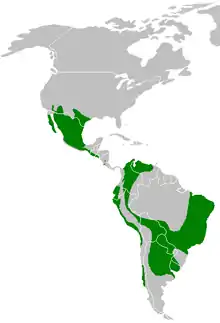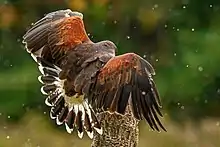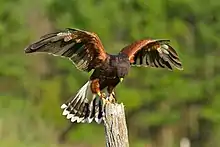Harris's hawk
Harris's hawk (Parabuteo unicinctus), formerly known as the bay-winged hawk or dusky hawk, and known in Latin America as peuco, is a medium-large bird of prey that breeds from the southwestern United States south to Chile, central Argentina, and Brazil. Birds are sometimes reported at large in Western Europe, especially Britain, but it is a popular species in falconry and these records almost certainly all refer to escapes from captivity.
| Harris's hawk | |
|---|---|
_3_of_4_in_set.jpg.webp) | |
| Scientific classification | |
| Kingdom: | Animalia |
| Phylum: | Chordata |
| Class: | Aves |
| Order: | Accipitriformes |
| Family: | Accipitridae |
| Genus: | Parabuteo |
| Species: | P. unicinctus |
| Binomial name | |
| Parabuteo unicinctus (Temminck, 1824) | |
| Subspecies | |
|
P. u. harrisi | |
 | |
| Distribution map of Parabuteo unicinctus | |
| Synonyms | |
|
Falco harrisii Audubon 1839 | |
The name is derived from the Greek para, meaning beside, near or like, and the Latin buteo, referring to a kind of buzzard; uni meaning once; and cinctus meaning girdled, referring to the white band at the tip of the tail.[2] John James Audubon gave this bird its English name in honor of his ornithological companion, financial supporter, and friend Edward Harris.[3]
The Harris's hawk is notable for its behavior of hunting cooperatively in packs consisting of tolerant groups, while other raptors often hunt alone. Harris hawks' social nature has been attributed to their intelligence, which makes them easy to train and have made them a popular bird for use in falconry.[4]
Description

This medium-large hawk is roughly intermediate in size between a peregrine falcon (Falco peregrinus) and a red-tailed hawk (Buteo jamaicensis). Harris's hawks range in length from 46 to 59 cm (18 to 23 in) and generally have a wingspan of about 103 to 120 cm (41 to 47 in)[5][6] These hawks have a brownish plumage, reddish shoulders and tail feathers with a white base and white tip.[7]
They exhibit sexual dimorphism with the females being larger by about 35%. In the United States, the average weight for adult males is about 701 g (1.545 lb), with a range of 546 to 850 g (1.204 to 1.874 lb), while the adult female average is 1,029 g (2.269 lb), with a range of 766 to 1,633 g (1.689 to 3.600 lb).[8][9] They have dark brown plumage with chestnut shoulders, wing linings, and thighs,[10] white on the base and tip of the tail,[11] long, yellow legs and a yellow cere.[12] The vocalizations of the Harris's hawk are very harsh sounds.[5]
Juvenile

The juvenile Harris's hawk is mostly streaked with buff, and appears much lighter than the dark adults. When in flight, the undersides of the juveniles' wings are buff-colored with brown streaking. They can look unlike adults at first glance, but the identical chestnut plumage is an aid for identification.[12]
Subspecies
There are three subspecies of Harris's hawk:
- P. u. superior: found in Baja California, Arizona, Sonora, and Sinaloa. P. u. superior was believed to have longer tails and wings and to be more blackish than P. u. harrisi. However, the sample size of the original study was quite small, with only five males and six females. Later research has concluded that there is not as strong a physical difference as was originally assumed.[13] Other ecological differences, such as latitudinal cline were also brought up as arguments against the validity of the subspecies segmentation.[14]
- P. u. harrisi: found in Texas, eastern Mexico, and much of Central America.[14]
- P. u. unicinctus: found exclusively in South America. It is smaller than the North American subspecies.[14]
Distribution and habitat
Harris's hawks live in sparse woodland and semi-desert, as well as marshes (with some trees) in some parts of their range (Howell and Webb 1995), including mangrove swamps, as in parts of their South American range.[15] Harris's hawks are permanent residents and do not migrate.[14] Important perches and nest supports are provided by scattered larger trees or other features (e.g., power poles, woodland edges, standing dead trees, live trees, and boulders, and saguaros).[16]
The wild Harris's hawk population is declining due to habitat loss; however, under some circumstances, they have been known to move into developed areas.[17]
Behaviour

This species occurs in relatively stable groups. A dominance hierarchy occurs in Harris's hawks, wherein the mature female is the dominant bird, followed by the adult male and then the young of previous years. Groups typically include from 2 to 7 birds. Not only do birds cooperate in hunting, they also assist in the nesting process.[18] No other bird of prey is known to hunt in groups as routinely as this species.[19]
Feeding
.jpg.webp)
The diet of the Harris's hawk consists of small creatures including birds, lizards, mammals, and large insects. Because it often hunts in groups, the Harris's hawk can also take down larger prey.[20] Although not particularly common, the Harris's hawk may take prey weighing over 2 kg (4.4 lb), such as adult jackrabbits, great blue heron (Ardea herodias) and half-grown wild turkeys (Meleagris gallapavo).[21][22][23] The desert cottontail (Syvilagus auduboni), the leading prey species in the north of the Harris's hawk range, usually weighs 800 g (1.8 lb) or less.[24] Undoubtedly because it pursues large prey often, this hawk has larger and stronger feet, with long talons, and a larger, more prominent hooked beak than most other raptors around its size.[9] Locally, other buteonine hawks, including the ferruginous hawk, the red-tailed hawk and the white-tailed hawk also hunt primarily cottontails and jackrabbits, but each are bigger, weighing about 500 g (18 oz), 300 g (11 oz) and 200 g (7.1 oz), respectively, more on average than a Harris's hawk.[25][26][27][28][29]
In the Southwestern United States, the most common prey species (in descending order of prevalence) are desert cottontail (Syvilagus auduboni), eastern cottontail (Syvilagus floridanus), black-tailed jackrabbit (Lepus californicus), ground squirrels (Ammopsermophilus spp. and Spermophilus spp.), woodrats (Neotoma spp.), kangaroo rats (Dipodomys spp.), pocket gophers (Geomys and Thomomys spp.), Gambel's quail (Callipepla gambelii), scaled quail (C. squamata), northern bobwhite (Colinus virginianus), cactus wren (Campylorhynchus brunneicapillus), northern mockingbird (Mimus polyglottos), desert spiny lizards (Sceloporus magister), and skinks (Eumeces spp.)[30][31] In the tropics, Harris's hawks have adapted to taking prey of several varieties, including those like chickens and European rabbits introduced by man.[32][33] In Chile, the common degu (Octodon degus) makes up 67.5% of the prey.[34]
Hunting
.jpg.webp)
While most raptors are solitary, only coming together for breeding and migration, Harris's hawks will hunt in cooperative groups of two to six. This is believed to be an adaptation to the lack of prey in the desert climate in which they live. In one hunting technique, a small group flies ahead and scouts, then another group member flies ahead and scouts, and this continues until prey is bagged and shared. In another, all the hawks spread around the prey and one bird flushes it out.[35] Groups of Harris's hawks tend to be more successful at capturing prey than lone hawks, with groups of two to four individuals having ~10% higher success rates per extra individual.[36]
Breeding
They nest in small trees, shrubby growth, or cacti. The nests are often compact, made of sticks, plant roots, and stems, and are often lined with leaves, moss, bark and plant roots. They are built mainly by the female. There are usually two to four white to blueish white eggs sometimes with a speckling of pale brown or gray. The nestlings start out light buff, but in five to six days turn a rich brown.[37]
Very often, there will be three hawks attending one nest: two males and one female.[20] Whether or not this is polyandry is debated, as it may be confused with backstanding (one bird standing on another's back).[38] The female does most of the incubation. The eggs hatch in 31 to 36 days. The young begin to explore outside the nest at 38 days, and fledge, or start to fly, at 45 to 50 days. The female sometimes breeds two or three times in a year.[37] Young may stay with their parents for up to three years, helping to raise later broods. Nests are known to be predated by coyotes (Canis latrans), golden eagles (Aquila chrysaetos), red-tailed hawks (Buteo jamaicensis), great horned owls (Bubo virginianus) and flocks of common ravens (Corvus corax), predators possibly too formidable to be fully displaced by the Harris's hawk's cooperative nest defenses. No accounts show predation on adults in the United States and the Harris's hawk may be considered an apex predator, although presumably predators like eagles and great horned owls would be capable of killing them.[39] In Chile, black-chested buzzard-eagles (Geranoaetus melanoleucus) are likely predators.[40]
Relationship with humans
Falconry

Since about 1980, Harris's hawks have been increasingly used in falconry and are now the most popular hawks in the West (outside of Asia) for that purpose, as they are one of the easiest to train and the most social.[41]
Trained Harris's hawks have been used to remove an unwanted pigeon population from London's Trafalgar Square, and from the tennis courts at Wimbledon.[42]
Trained Harris hawks have been used for bird abatement by falconers in the United States at various locations including resorts and industrial sites.[43]
In art
John James Audubon illustrated the Harris's hawk in The Birds of America (published, London 1827–38) as Plate 392 with the title "Louisiana Hawk -Buteo harrisi". The image was engraved and colored by the Robert Havell, London workshops in 1837. The original watercolor by Audubon was purchased by the New York History Society where it remains to this day (January 2009).[44]
References
- BirdLife International (2012). "Parabuteo unicinctus". IUCN Red List of Threatened Species. 2012. Retrieved 26 November 2013.
- Jobling, James A. (1991). A Dictionary of Scientific Bird Names. ISBN 978-0-19-854634-4.
- National Audubon Society. "Audubon". Audubon. Archived from the original on 2008-04-09. Retrieved 2013-04-29.
- Beebe, Frank (1984). A Falconry Manual. Hancock House Publishers, ISBN 0-88839-978-2, page 81.
- Udvardy, Miklos D. F. (2001). National Audubon Society Field Guide to North American Birds 'Western Region'. ISBN 978-0-679-42851-0.
- Clark, W. S. and B. K. Wheeler. (1987). A Field Guide to Hawks of North America. Houghton Mifflin Co. Boston.
- "Harris's Hawk - Appearance". 2015. Retrieved October 22, 2018.
- Dunning, John B. Jr. (1993). CRC Handbook of Avian Masses. ISBN 978-0-8493-4258-5.
- Hamerstrom, F. (1978). External sex characters of Harris' Hawks in winter. Raptor Res. 12:1–14.
- National Geographic Society (1983). Birds of North America. ISBN 978-0-87044-472-2.
- Sibley, David Allen (2000). National Audubon Society The Sibley Guide to Birds. ISBN 978-0-679-45122-8.
- Rappole, John H. (2000). Birds of the Southwest. ISBN 978-0-89096-958-8.
- Bednarz, J. C. (1988). "Harris' hawk subspecies: is superior larger or different than harrisi?". in Proceedings of the southwest raptor management symposium and workshop. Washington, D.C. pp. 294–300.
- Bednarz, James C. (1995). "Harris's Hawk (Parabuteo unicinctus)".
- (in Spanish) Olmos Fábio & Robson Silva e Silva (2003). Guará-Ambiente, Flora e Fauna dos Manguezais de Santos-Cubatão Empresa das Artes, ISBN 85-89138-06-2
- Bednarz, J. C. and J. D. Ligon. (1988). A study of the ecological bases of cooperative breeding in the Harris' hawk. Ecology 69:1176–1187.
- Discoll, James T. "Harris' Hawk". Archived from the original on 2007-11-23. Retrieved 2007-11-19.
- Dawson, J. W. and R. W. Mannan. (1991). The role of territoriality in the social organization of Harris' hawks. Auk 108:661–672.
- Griffin, C. R. (1976). A preliminary comparison of Texas and Arizona Harris' Hawks (Parabuteo unicinctus) populations. Raptor Res. 10:50–54.
- Kaufmann, Kenn (1996). Lives of North American Birds. ISBN 978-0-395-77017-7.
- Bednarz, J. C. (1988). A comparative study of the breeding ecology of Harris's and Swainson's hawks in southeastern New Mexico. Condor 90:311–323.
- Woodward, H.D. (2003). Lone Harris' Hawk Kills Great Blue Heron. The Raptor Research Foundation 1:85–86.
- Houcke, H.H. (1971). Predation By a White-Tailed Hawk and a Harris' Hawk on a Wild Turkey Poult Condor 4: 475.
- Bednarz, J. C., J. W. Dawson, and W. H. Whaley. (1988). Harris' Hawk. Pages 71–82 in Proceedings of the southwest raptor management symposium and workshop. (Glinski, R. L., B. G. Pendleton, M. B. Moss, M. N. LeFranc, Jr., B. A. Millsap, and S. W. Hoffman, Eds.) Natl. Wildl. Fed. Washington, D.C.
- Smith, D. G. and J. R. Murphy. (1978). Biology of the Ferruginous Hawk in central Utah. Sociobiology 3:79–98.
- Thurow, T. L., C. M. White, R. P. Howard, and J. F. Sullivan. (1980). Raptor ecology of Raft River valley, Idaho. EG&G Idaho, Inc. Idaho Falls.
- Smith, D. G. and J. R. Murphy. (1973). Breeding ecology of raptors in the East Great Basin Desert of Utah. Brigham Young Univ. Sci. Bull., Biol. Ser. Vol. 18:1–76.
- Farquhar, C. C. (1986). Ecology and breeding behavior of the White-tailed Hawk on the northern coastal prairies of Texas. PhD. diss. Texas A & M Univ. College Station.
- Dunning Jr., John B. (Editor). (1992). CRC Handbook of Avian Body Masses. CRC Press. ISBN 978-0-8493-4258-5.
- Mader, W. J. (1975). Biology of the Harris' hawk in southern Arizona. Living Bird 14:59–85.
- Brannon, J. D. (1980). The reproductive ecology of a Texas Harris's hawk (Parabuteo unicinctus harrisi) population. Master's Thesis. Univ. of Texas, Austin.
- Nutting, C. C. (1883). On a collection of birds from the Hacienda "La Palma," Gulf of Nicoya, Costa Rica, with critical notes by Robert Ridgway. Proc. U.S. Natl. Mus. 1982(5):382–409.
- Johnson, A. W. (1965). The birds of Chile and adjacent regions of Argentina, Bolivia, and Peru. Platt Establecimientos Graficos, Buenos Aires.
- Jaksic, F. M., J. L. Yanez, and R. P. Schlatter. (1980). Prey of the Harris' hawk in central Chile. Auk 97:196–198.
- Cook, William E. (1997). Avian Desert Predators. ISBN 978-3-540-59262-4.
- Dawson, James (1988). "The cooperative breeding system of the Harris' Hawk in Arizona". The University of Arizona. Retrieved 17 November 2017. Cite journal requires
|journal=(help) - Baicich, Paul J.; Harrison, Colin J. O. (1997). Nests, Eggs, and Nestlings of North American Birds. ISBN 978-0-691-12295-3.
- Ligon, J. David (1999). The Evolution of Avian Breeding Systems. Oxford Ornithology Series. 10. Oxford University Press. ISBN 978-0198549130. Retrieved 4 August 2013.
- Dawson, J. W. and R. W. Mannan. (1991). Dominance hierarchies and helper contributions in Harris' Hawks. Auk 108:649–660.
- Jiménez, J. E., & Jaksić, F. M. (1989). Behavioral ecology of grey eagle-buzzards, Geranoaetus melanoleucus, in central Chile. Condor 913–921.
- "Raptors page". Users.cybercity.dk. Archived from the original on 2013-03-05. Retrieved 2013-04-29.
- Mount, Harry (2017-07-03). "Introducing Rufus the hawk: the official bird scarer of the Wimbledon Championships". Telegraph. Retrieved 2018-10-22.
- Mraz, Tiffany. "BLOG: Phoenician resort hires hawks to keep pesky birds away from diners". AZFamily. Retrieved 2020-08-19.
- "Audubon's Watercolors Octavo Pl. 392, Harris' Hawk". Joel Oppenheimer, Inc. Retrieved 2019-10-29.
External links
| Wikimedia Commons has media related to Parabuteo unicinctus. |
| Wikispecies has information related to Parabuteo unicinctus. |
- Peregrine Fund page on Harris' hawk
- Harris's hawks in falconry (videos, Photo album, articles) In Italian
- Harris' hawks hunting in pack ( video )
Historical material
- John James Audubon. "Louisiana Hawk", Ornithological Biography volume 5 (1839). Illustration from Birds of America octavo edition, 1840.
